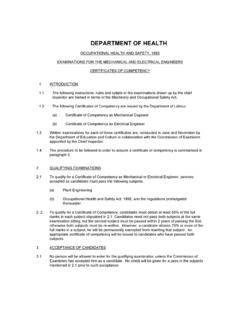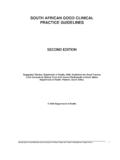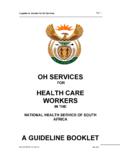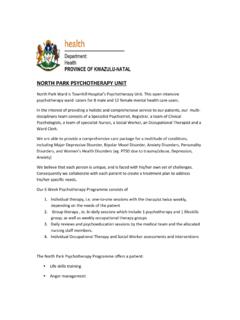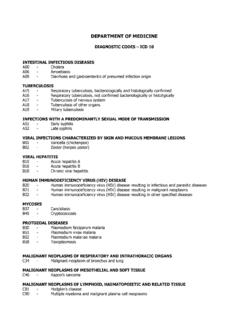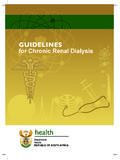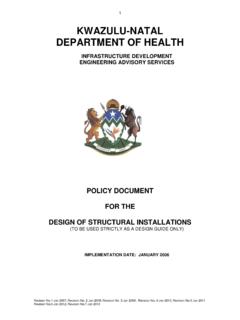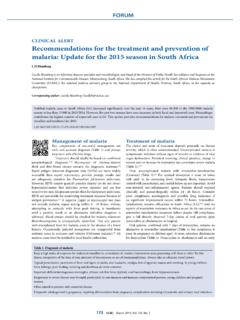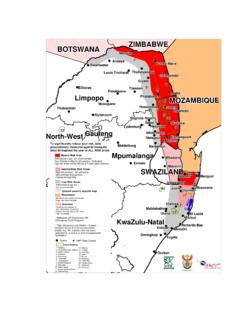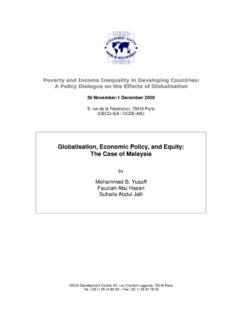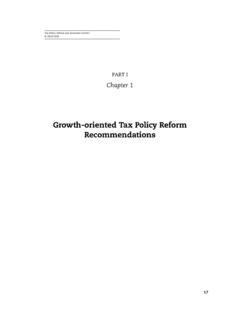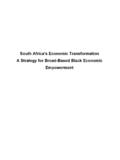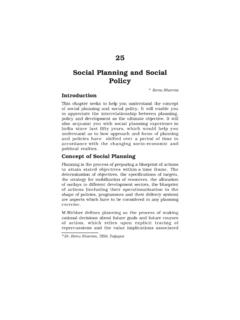Transcription of TABLE OF CONTENTS - Department of Health
1 TABLE OF CONTENTS . LIST OF ACRONYMS ..2. INTRODUCTION - THE transformation OVERCOMING THE economic LEGACY OF APARTHEID ..6. Introduction ..6. The legacy of Apartheid ..6. Dismantling Apartheid, stabilising the economy and extending basic Deracialising the South African economy and laying the foundation for Broad-Based black economic empowerment ..8. Financial support from government for BEE ..9. Achievements and lessons learned ..10. Conclusion .. 11. A STRATEGY FOR BROAD-BASED black economic Introduction ..12. Defining Broad-Based black economic empowerment ..12. Policy objectives of BEE ..12. Key Policy instruments to achieve BEE ..14. Finance for BEE ..17. The IDC's role in financing black economic empowerment ..18. THE WAY FORWARD ..20. Appendix A - A balanced scorecard for Broad-Based black economic empowerment ..21. Appendix B - Definitions of black empowerment Entities ..25.
2 Appendix C - Draft regulations governing the functioning and establishment of the black economic empowerment Advisory Council ..26. Appendix D - Aligning the current support measures with the broad-based black economic empowerment strategy ..28. 1. List of Acronyms ANC African National Congress BBSDP black Business Supplier Development Programme BEE black economic empowerment (BEE). BEECom black economic empowerment Commission BOSMEs black -Owned Small and Medium Enterprises CBO Community-Based Organisation CBPWP Community-Based Public Works Programme Cosatu Congress of South African Trade Unions CPPP Community Public Private Sector Partnership CR Community Reinvestment CRA Community Reinvestment Act CSIR Council for Scientific and Industrial Research DACST Department of Arts, Culture, Science and Technology DBSA Development Bank of Southern Africa DEAT Department of Environmental Affairs and Tourism DFI Development Finance Institutions DLA Department of Land Affairs DME Department of Minerals and Energy DoE Department of Education DoH Department of Housing DoL Department of Labour DPLG Department of Provincial and Local Government DPSA Department of Public Service and Administration DPW Department of Public Works DWAF Department of Water Affairs and Forestry EAP Economically Active Population EDSA Entrepreneurial Development Southern Africa EIG empowerment Investment Grant EMIA Export Marketing and Investment Assistance ESC Entrepreneurial Support Centre ESOP Employee Share Ownership Programme FIG Foreign Investment Grant GDP Gross Domestic Product GEAR Growth.
3 Employment and Redistribution HBDC Highveld Business Development Centre HDIs Historically Disadvantaged Individuals HDPs Historically Disadvantaged Persons HDPs Historically Disadvantaged Persons HEDC Highveld Entrepreneurial Development Centre HRD Human Resources Development ICT Information and Communication Technology ICTs Information and Communication Technologies IDC Industrial Development Corporation 2. IDRC Independent Development Research Centre IDT Independent Development Trust IDU Investment Development Unit IDZ Industrial Development Zone IMS Integrated Manufacturing Strategy ISRDS Integrated Sustainable Rural Development Strategy LBSC Local Business Service Centre LED Local economic Development MAC Manufacturing Advice Centre MAP Manufacturing Advice Programme MFI Micro-Finance Industry MFRC Micro-Finance Regulatory Council MTEF Medium-Term Expenditure Framework NAFCOC National African Federated Chamber of Commerce NEDLAC National economic Development and Labour Council NEF National empowerment Fund NGOs Non-governmental organisations PII Partnership in Industrial Innovation PPFA Preferential Procurement Framework Act PPP Public Private Partnerships R&D Research and Development RDP Reconstruction and Development Programme RFI Retail Finance Institutions RIDP Regional
4 Industrial Development Programme SADC Southern African Development Community SARS South African Revenue Service SDIs Spatial Development Initiatives SICs Standard Identification Codes SME Small and Medium Enterprise SMEDP Small and Medium Enterprise Development Programme SMME Small, Micro and Medium Enterprise SOE State-Owned Enterprise SPF Sector Partnership Fund SPII Support Programme for Industrial Innovation SPV Special Purpose Vehicle SR Social Responsibility TDI Targeted Development Investment TEO The Enterprise Organisation the dti The Department of Trade and Industry TIDP Trade and Industrial Development Programme URP Urban Renewal Programme 3. South Africa's economic transformation : A Strategy for Broad-Based black economic empowerment Notes INTRODUCTION - THE transformation IMPERATIVE. Our country requires an economy that can meet the needs of all our economic citizens our people and their enterprises in a sustainable manner.
5 This will only be possible if our economy builds on the full potential of all persons and communities across the length and breadth of this country. Government's objective is to achieve this vision of an adaptive economy characterised by growth, employment and equity by 2014. Apartheid systematically and purposefully restricted the majority of South Africans from meaningful participation in the economy. The assets of millions of people were directly and indirectly destroyed and access to skills and to self-employment was racially restricted. The accumulation process under Apartheid confined the creation of wealth to a racial minority and imposed underdevelopment on black communities. The result is an economic structure that today, in essence, still excludes the vast majority of South Africans. It is crucial to understand the magnitude of what took place in our past in order to understand why we need to act together as a nation to bring about an economic transformation in the interest of all.
6 The vision of an economy that meets the needs of the people in a more equitable manner goes back to the Freedom Charter of 1955. This was refined and developed in the contemporary context in the Reconstruction and Development Programme (1994). The need to effect redress in the interests of equity is also embodied in our Constitution. Subsequently, government has outlined broad economic strategies to transform the economy by 2014. These strategies include the Microeconomic Reform Strategy and a range of specific strategies such as the Integrated Manufacturing Strategy and the National Research and Development Strategy. The period since 1994 has seen the South African economy undergo profound restructuring. Ten years of consistent economic growth has been recorded. Macroeconomic stabilisation has largely been achieved, providing a platform for accelerating the growth rate. The economy has become increasingly integrated into global markets and has become a successful exporter of manufactured goods and value-added services.
7 South Africa is now able to position itself as an advanced manufacturing economy. Despite the economic successes and a broad range of state policy, strategy and programme interventions aimed at overcoming economic disparities, entrenched inequalities continue to characterise the economy and act as a deterrent to growth, economic development, employment creation and poverty eradication. Vast racial and gender inequalities in the distribution of and access to wealth, income, skills and employment persist. As a consequence, our economy continues to perform below its full potential. Societies characterised by entrenched gender inequality or racially or ethnically defined wealth disparities are not likely to be socially and politically stable, particularly as economic growth can easily exacerbate these inequalities. Therefore the medium- to long-term sustainability of such unequal economies is vulnerable.
8 Accordingly, in South Africa, the socio-political and moral imperative to redress racial discrimination is also an imperative dictated by the need for sustainable growth. South Africa's integration into the global economy means that it is exposed to both the positive and negative forces that constitute the process of globalisation. Globalisation can further entrench existing inequalities and further marginalise those on the periphery. Increased inequality and uneven development poses a real danger for all economies, both developing and industrialised. In South Africa, however, inequality and uneven development have extremely strong racial characteristics, which represent a threat to our young democracy. Therefore, 4. Notes an economic transformation strategy must form part of government's strategic approach to globalisation to ensure that we benefit from these processes and not suffer deleterious effects.
9 More than just an economic imperative, the deracialisation and engendering of our economy is a moral requirement in keeping with the values and principles of equity enshrined in our Constitution. Progress has been recorded in undoing the legacy of the past, however, the extent to which this economic success has been shared by all of our people is still inadequate for the requirements of a stable and prosperous society. The time is right for the introduction of a comprehensive and focused strategy for broad- based black economic empowerment . black economic empowerment is already an unfolding process in our economy, however, this document outlines the more comprehensive and focused strategy that is now needed and adds impetus to the process by providing greater clarity and certainty. The document begins with an analysis of the legacy of dispossession and disempowerment that characterised our economic development until 1994.
10 It is essential that we understand this in order to comprehend actions which are needed for success. The steps taken to overcome this legacy are examined and lessons from this experience are extracted. This strategy document is the outcome of an extensive consultation process within government and with the private sector. It is informed by contributions of the black economic empowerment Commission as well as the views of the President's black Business and Big Business working groups. The Trade and Industry Chamber of the National economic Development and Labour Council have also considered the matter and their inputs have been incorporated. The strategy consists of a policy statement and a statement of the policy instruments that government will be using consistently and predictably. These include the formalisation of partnerships and charters' with the private sector;. the use of a balanced scorecard' approach for gauging success; and, an Act that allows for the formalisation of guidelines and codes and the establishment of an Advisory Council.

